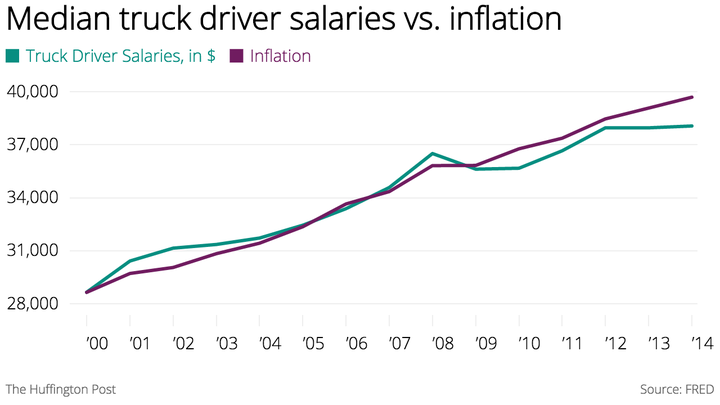
There is a shortage of truck drivers in the United States.
Unsurprisingly, that's leading to a bidding war for qualified truckers among the big companies. The Wall Street Journal recently reported on the need for 48,000 truckers in an industry of 800,000.
It's not shocking that the country faces a trucker shortage: Days on the job are long, it's hard to have a family, and drivers are required to be in a seat and watch the road for hours at a time. In addition to that, pay bumps couldn't even keep up with inflation between 2000 and 2014.
This chart shows how median truck driver salaries have grown since 2000 (the green line). It also shows how a driver's salary in 2000 would have changed if it had simply kept up with inflation (the purple line).

When the green line dips below the purple line -- salaries since 2008, basically -- that means pay isn't keeping up with inflation. At the beginning of 2014, a truck driver's salary was effectively lower than it was in 2000. (The numbers are slightly different than those in the WSJ, because the Bureau of Labor Statistics includes other kinds of drivers, like FedEx drivers and local delivery driver, in addition to long-haul drivers.)
But the data in the chart stops in 2014, just when things started to change in the industry. Companies began working to remedy the shortage in the economically proven way to increase demand: by offering more money.
The WSJ writes that "average pay for long-haul truckers jumped 17% since the end of 2013 to a record $57,000 this year, according to the National Transportation Institute, a research group. U.S. wages rose by less than 4% over the same period."
The industry, of course, would prefer not to raise wages if it could find any other way to increase the number of available drivers. A separate WSJ story from Friday notes that the trucking industry is trying to get Congress to lower the age at which drivers are allowed to drive freight across state lines. Currently, a person can get a commercial drivers license at 18 but has to wait until 21 to drive commercially between states.
And this is just a stop-gap measure to tide the industry until, of course, the self-driving trucks take over.
